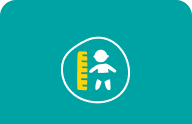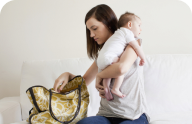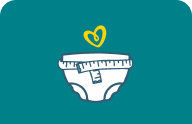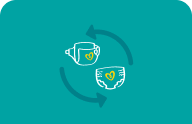Home Remedies for Diaper Rash
Diaper rash is a common issue that many parents face, and it may be distressing for both the baby and the parent. While it’s always best to consult your baby’s healthcare provider for advice, some home remedies for diaper rash may help soothe your little one’s skin. In this article, we'll explore these remedies, provide tips on what to avoid, and guide you when it’s time to seek professional care. Let’s dive into some practical, safe, and effective ways to help your baby feel more comfortable at home.
Home Remedies for Diaper Rash
When your little one develops a diaper rash, it’s natural to want to find relief as quickly as possible. While there are many over-the-counter treatments available, some parents prefer to start with natural remedies for diaper rash at home.
Apply Human Breast Milk
One of the most natural and accessible home remedies for diaper rash is human breast milk. Some parents find that applying a small amount of breast milk to the affected area may help soothe the irritation and promote healing, although scientific evidence is limited. Breast milk is believed to have anti-inflammatory and antibacterial properties that may benefit the skin. If you are considering using breast milk as a remedy, it’s essential to discuss this with your baby’s healthcare provider to ensure it’s appropriate for your child. While this method might be appealing to those who prefer natural remedies for diaper rash, it’s important to monitor the rash closely. If it persists or worsens, seeking advice from your baby’s healthcare provider is recommended.
Increase Airflow
Among the most supported home remedies for diaper rash is ensuring your baby’s diaper area gets plenty of airflow. Allowing the diaper area to be exposed to air helps keep the skin dry, which may be crucial in both treating and preventing diaper rash. Diaper rash often occurs when the skin is exposed to moisture for prolonged periods. By giving your baby some diaper-free time, you allow the skin to breathe and dry out, which may help reduce the rash's severity and prevent further irritation This method is simple, safe, and may easily be incorporated into your baby’s daily routine to help manage and prevent diaper rash.
Change Diapers Frequently
Frequent diaper changes are a key part of any home treatment for diaper rash. Keeping your baby's diaper clean and dry will help prevent the likelihood of diaper rash and heal existing discomfort. Prolonged exposure to wet or soiled diapers is one of the most common causes of diaper rash, as moisture may irritate your baby’s sensitive skin. To minimize the risk of diaper rash, it’s important to check your baby’s diaper often and change it as soon as it’s wet or soiled. Choosing Pampers can be an important step in keeping your baby comfortable and dry, thanks to their superior absorbency and gentle materials designed for sensitive skin. This can be especially important at night when long stretches of sleep might lead to extended contact with a dirty diaper. When changing diapers, clean the diaper area gently with water and allow the skin to air dry before putting on a fresh diaper. Using this method consistently may help promote faster healing if a rash does develop.
Diaper Rash Treatments to Avoid
While many home remedies for diaper rash may be effective, some treatments should be approached with caution or avoided altogether. Not all remedies are suitable for every baby, and some might even worsen the condition. The following are a few treatments that should be used with care or avoided.
Baking Soda
Baking soda paste is sometimes suggested as a home cure for diaper rash due to its drying properties. However, it’s important to avoid using baking soda directly on your baby’s skin, as it may disrupt the natural pH balance and potentially cause further irritation. If you’re considering any home remedy, it’s best to consult your baby’s healthcare provider first.
Witch Hazel & Apple Cider Vinegar
So-called home remedies like witch hazel and apple cider vinegar are often mentioned online, but they may be harmful to your baby’s delicate skin. Both are acidic and may cause irritation rather than provide relief. It’s important to be cautious about what you apply to your baby’s skin to avoid causing more irritation or potentially leading to an infection.
Aloe Vera
Aloe vera is another remedy that may be soothing when used in its purest form, straight from the plant. However, many aloe vera products available in stores contain additional ingredients that may irritate your little one. If you choose to use aloe vera, ensure it’s pure and free from added chemicals or fragrances that could worsen the condition. Always consult with your baby’s health provider before continuing.
How to Treat Diaper Rash
Just as mentioned earlier, keeping the diaper area clean and dry is a great way to treat diaper rash. In addition to these methods, here are a few more steps you can take to help your baby’s skin recover:
Change diapers frequently. Keeping your baby’s diaper area as dry as possible is crucial. Check diapers often and change them as soon as they’re wet or soiled. This helps prevent further irritation and gives the skin a chance to heal. Learn how often to change your little one’s diaper in our informative article.
Clean gently. When changing diapers, gently clean your baby’s diaper area with warm water or a mild, fragrance-free baby wipe. Avoid rubbing the skin, as this may cause additional irritation. Pat the area dry with a soft towel or allow it to air dry naturally.
Apply a barrier cream. Using a diaper rash cream or ointment that contains zinc oxide or petroleum jelly may create a protective barrier on the skin, shielding it from moisture. Apply a thick layer of the cream at each diaper change to help protect the skin while it heals.
When to Contact a Healthcare Provider
While most diaper rashes may be treated at home, there are times when you should seek medical advice:
Rash persists or worsens. If the rash doesn’t improve after a few days or gets worse, consult a healthcare provider.
Severe rash. If the rash has blisters, open sores, or pus-filled bumps, it could indicate a bacterial infection that needs medical treatment.
Fever or unusual behavior. If your baby develops a fever or seems unusually fussy or lethargic, seek medical advice.
Infections. Bright red rashes with small bumps may indicate a yeast or bacterial diaper rash, requiring treatment.
Home remedies for a bad diaper rash are not recommended and you should always consult with your baby’s health care provider. Remember, timely intervention may ensure your baby gets the appropriate care and relief.
The Bottom Line
Diaper rashes are common, but they may often be treated effectively with simple home remedies. Keeping the diaper area clean, dry, and covered with barrier creams is an important step in treating the rash. Natural remedies for a diaper rash, like giving the skin some time to air out, may also provide relief. However, it’s important to approach any remedy cautiously and consult a healthcare provider if the rash doesn’t improve.
Be sure to check out this Diaper Checklist to stay prepared when you're on the go.
For added convenience, the Pampers Club app offers discounts and digital offers, helping parents care for their babies.
How We Wrote This Article The information in this article is based on expert advice found in trusted medical and government sources, such as the American Academy of Pediatrics and the American College of Obstetricians and Gynecologists. You can find a full list of sources used for this article below. The content on this page should not replace professional medical advice. Always consult medical professionals for full diagnosis and treatment.
Join a World of Support
through Pregnancy and Parenthood.










